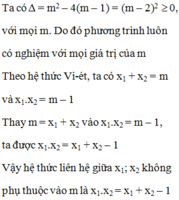Hãy nhập câu hỏi của bạn vào đây, nếu là tài khoản VIP, bạn sẽ được ưu tiên trả lời.

a: Khim=0 thì (1) trở thành \(x^2-2=0\)
hay \(x\in\left\{\sqrt{2};-\sqrt{2}\right\}\)
Khi m=1 thì (1) trở thành \(x^2-2x=0\)
=>x=0 hoặc x=2
b: \(\text{Δ}=\left(-2m\right)^2-4\left(2m-2\right)\)
\(=4m^2-8m+8=4\left(m-1\right)^2>=0\)
Do đó: Phương trình luôn có hai nghiệm

a: Khi m=-1 thì hệ phương trình sẽ là:
\(\left\{{}\begin{matrix}x\cdot2\cdot\left(-1\right)-3y=2\cdot\left(-1\right)-1\\4x-\left(-1+5\right)y=2\end{matrix}\right.\)
=>\(\left\{{}\begin{matrix}-2x-3y=-3\\4x-4y=2\end{matrix}\right.\)
=>\(\left\{{}\begin{matrix}-4x-6y=-6\\4x-4y=2\end{matrix}\right.\Leftrightarrow\left\{{}\begin{matrix}-6y-4y=-6+2\\x-y=\dfrac{1}{2}\end{matrix}\right.\)
=>\(\left\{{}\begin{matrix}-10y=-4\\x-y=\dfrac{1}{2}\end{matrix}\right.\Leftrightarrow\left\{{}\begin{matrix}y=\dfrac{2}{5}\\x=\dfrac{1}{2}+\dfrac{2}{5}=\dfrac{9}{10}\end{matrix}\right.\)
b: Để hệ phương trình có nghiệm duy nhất thì \(\dfrac{2m}{4}\ne-\dfrac{3}{-\left(m+5\right)}\)
=>\(\dfrac{m}{2}\ne\dfrac{3}{m+5}\)
=>\(m^2+5m\ne6\)
=>\(m^2+5m-6\ne0\)
=>\(\left(m+6\right)\left(m-1\right)\ne0\)
=>\(m\notin\left\{-6;1\right\}\)
c: \(\left\{{}\begin{matrix}2mx-3y=2m-1\\4x-\left(m+5\right)y=2\end{matrix}\right.\)
=>\(\left\{{}\begin{matrix}4mx-6y=4m-2\\4mx-\left(m^2+5m\right)y=2m\end{matrix}\right.\)
=>\(\left\{{}\begin{matrix}-6y+\left(m^2+5m\right)y=2m-2\\4x-\left(m+5\right)y=2\end{matrix}\right.\)
=>\(\left\{{}\begin{matrix}y\left(m^2+5m-6\right)=2m-2\\4x-\left(m+5\right)y=2\end{matrix}\right.\)(1)
Khi \(m\notin\left\{-6;1\right\}\) thì hệ phương trình (1) sẽ trở thành:
\(\left\{{}\begin{matrix}y=\dfrac{2m-2}{m^2+5m-6}=\dfrac{2\left(m-1\right)}{\left(m+6\right)\left(m-1\right)}=\dfrac{2}{m+6}\\4x=2+\left(m+5\right)y=2+\dfrac{2m+10}{m+6}=\dfrac{4m+22}{m+6}\end{matrix}\right.\)
=>\(\left\{{}\begin{matrix}y=\dfrac{2}{m+6}\\x=\dfrac{4m+22}{4m+24}=\dfrac{2m+11}{2m+12}\end{matrix}\right.\)
Để hệ có nghiệm duy nhất thỏa mãn x>0 và y>0 thì \(\left\{{}\begin{matrix}m\notin\left\{-6;1\right\}\\\dfrac{2}{m+6}>0\\\dfrac{2m+11}{2m+12}>0\end{matrix}\right.\Leftrightarrow\left\{{}\begin{matrix}m\notin\left\{-6;1\right\}\\m+6>0\\\dfrac{2m+11}{m+6}>0\end{matrix}\right.\)
=>\(\left\{{}\begin{matrix}m\ne1\\m>-6\\\left[{}\begin{matrix}\left\{{}\begin{matrix}2m+11>0\\m+6>0\end{matrix}\right.\\\left\{{}\begin{matrix}2m+11< 0\\m+6< 0\end{matrix}\right.\end{matrix}\right.\end{matrix}\right.\Leftrightarrow\left\{{}\begin{matrix}m\ne1\\m>-6\\\left[{}\begin{matrix}m>-\dfrac{11}{2}\\m< -6\end{matrix}\right.\end{matrix}\right.\Leftrightarrow\)\(\left\{{}\begin{matrix}m\ne1\\m>-\dfrac{11}{2}\end{matrix}\right.\)

a, Với m=2 thì phương trình (1) trở thành
x mũ 2 + 2(2+2)x +4.2 -1 =0
<=> x mũ 2 + 8x +7 =0
<=> x mũ 2 + x + 7x +7 =0
<=> (x+1)(x+7) =0
<=> x= -1 hoặc x= -7
b, Ta có:
penta' = (m+2)mũ2 - 4m -1
= m m 2 +4m +4 -4m -1
= m mũ2 +3
vì m mũ2 luôn > hoặc = 0 với mọi m
suy ra m mũ2 +3 luôn >0 với mọi m
suy ra penta' >0 hay có hai nghiệm phân biệt (đpcm)
CÒN PHẦN SAU THÌ MK KO BIẾT LÀM .... THÔNG CẢM

a, Thay m = 1 ta đc
\(x^2-1=0\Leftrightarrow x=1;x=-1\)
b, \(\Delta'=\left(m-1\right)^2-\left(2m-3\right)=m^2-4m+4=\left(m-2\right)^2\)
Để pt có 2 nghiệm pb khi delta' > 0
\(m-2\ne0\Leftrightarrow m\ne2\)
c, để pt có 2 nghiệm trái dấu khi \(x_1x_2=2m-3< 0\Leftrightarrow m< \dfrac{3}{2}\)
d.
Theo Viet: \(\left\{{}\begin{matrix}x_1+x_2=2m-2\\x_1x_2=2m-3\end{matrix}\right.\)
Trừ vế cho vế:
\(\Rightarrow x_1+x_2-x_1x_2=1\)
Đây là hệ thức liên hệ 2 nghiệm ko phụ thuộc m

\(\text{Δ}=\left(2m-1\right)^2-4\cdot2\cdot\left(m-1\right)\)
\(=4m^2-4m+1-8m+8\)
\(=4m^2-12m+9=\left(2m-3\right)^2>=0\forall m\)
=>Phương trình luôn có hai nghiệm
Theo Vi-et, ta có:
\(\left\{{}\begin{matrix}x_1+x_2=-\dfrac{b}{a}=\dfrac{-2m+1}{2}\\x_1\cdot x_2=\dfrac{c}{a}=\dfrac{m-1}{2}\end{matrix}\right.\)
\(x_1+x_2+2x_1x_2\)
\(=\dfrac{-2m+1}{2}+\dfrac{2\left(m-1\right)}{2}\)
\(=\dfrac{-2m+1+2m-2}{2}=\dfrac{-1}{2}\)
=>\(x_1+x_2+2x_1x_2\) là hệ thức cần tìm

1) Với m = 1 thì ta có:
\(x^2-2\left(1-1\right)x+2\cdot1-3=0\)
\(\Leftrightarrow x^2-1=0\)
\(\Leftrightarrow\left(x-1\right)\left(x+1\right)=0\)
\(\Leftrightarrow\orbr{\begin{cases}x-1=0\\x+1=0\end{cases}}\Leftrightarrow\orbr{\begin{cases}x=1\\x=-1\end{cases}}\)
2) Ta có: \(\Delta^'=\left[-\left(m-1\right)\right]^2-\left(2m-3\right)\cdot1=m^2-2m+1-2m+3\)
\(=m^2-4m+4=\left(m-2\right)^2\ge0\left(\forall m\right)\)
=> PT luôn có nghiệm với mọi m
Theo hệ thức viet ta có:
\(\hept{\begin{cases}x_1+x_2=2\left(m-1\right)\\x_1x_2=2m-3\end{cases}}\Leftrightarrow\hept{\begin{cases}x_1+x_2-1=2m-3\\x_1x_2=2m-3\end{cases}}\)
\(\Rightarrow x_1+x_2-1=x_1x_2\)
\(\Leftrightarrow x_1x_2-\left(x_1+x_2\right)+1=0\)

\(x^2-2\left(m+1\right)x+2m=0\left(1\right)\)
a, \(\Delta'=\left(m+1\right)^2-2m=m^2+>0\forall m\)
⇒ Phương trình có hai nghiệm phân biệt
b, Để phương trình có hai nghiệm cùng dương thì :
\(\left\{{}\begin{matrix}\Delta'>0\\S>0\\P>0\end{matrix}\right.\Leftrightarrow\left\{{}\begin{matrix}m^2+1>0\left(luôn-đúng\right)\\2\left(m+1\right)>0\\2m>0\end{matrix}\right.\)\(\Leftrightarrow\left\{{}\begin{matrix}m>-1\\m>0\end{matrix}\right.\)\(\Leftrightarrow m>0\)
c, Theo viét \(\left\{{}\begin{matrix}x_1+x_2=2\left(m+1\right)\left(2\right)\\x_1x_2=2m\left(3\right)\end{matrix}\right.\)
Trừ vế theo vế (2) cho (3) được : \(x_1+x_2-x_1x_2=2m+2-2m=2\)
Kết luận ....

- Xét phương trình đề cho có :
\(\Delta^,=b^{,2}-ac=\left(m-1\right)^2-\left(m-2\right)=m^2-2m+1-m+2\)
\(=m^2-3m+3\ge\dfrac{3}{4}>0\)
- Phương trình luôn có hai nghiệm phân biệt với mọi m .
- Theo vi ét : \(\left\{{}\begin{matrix}x_1+x_2=2\left(m-1\right)=2m-2\\x_1x_2=m-2\end{matrix}\right.\)
\(\Rightarrow\left\{{}\begin{matrix}x_1+x_2=2\left(m-1\right)=2m-2\\2x_1x_2=2m-4\end{matrix}\right.\)
\(\Rightarrow x_1+x_2-2x_1x_2=2m-2-2m+4=2\)

a: Thay m=2 vào pt, ta được:
\(x^2-4x+1=0\)
\(\Leftrightarrow\left[{}\begin{matrix}x=\sqrt{3}+2\\x=-\sqrt{3}+2\end{matrix}\right.\)